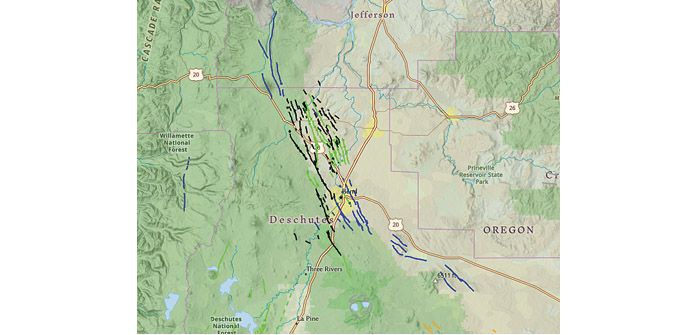(Fault map displaying local, shallow fault traces of central Oregon | Map courtesy of Wallace Group — usgs.maps.arcgis.com/apps/webappviewer)
What kind of earthquake hazards exist in Central Oregon?
Should we be concerned?
And what do we do about it?
It is a common misconception that there are no earthquake hazards in central Oregon due to the shallow rock in Bend and the area’s distance from the mega fault off the Oregon coast. Central Oregon is after all the state’s safe haven for those that will be affected by the looming Cascadia Subduction zone “big one.” While, in comparison to the Oregon coast and the Portland area, our risk of damage and injury are much lower; construction in central Oregon still needs to address and design for earthquake hazards. Wallace Group, a Bend firm specializing in central Oregon’s geosystem, evaluates the potential for earthquake hazards on development and construction projects throughout the region. A seismic hazard analysis is included in every Wallace Group geotechnical exploration.
It helps to first get some background on the geology in the region. Our local geology includes shallow basalt bedrock with deep groundwater in Bend; thick sand, and gravel deposits with areas of shallow groundwater in Prineville; and deep sands with shallow groundwater in La Pine. When an earthquake occurs, the shaking experienced at the ground surface is a function of the magnitude of the earthquake, distance from the fault, and the thickness and type of soil over rock. Earthquake motions with shallow rock will exhibit strong, but short shaking periods while deep soil areas can exhibit much longer durations. Shaking with deep soft or loose soil can be equated to shaking a bowl full of Jell-O.
Central Oregon may experience shaking from two different types of faults, the Cascadia Subduction Zone (CSZ) off the Oregon coast and local, shallow faults. During design, Wallace Group considers the effect on design of both types of faults.
The CSZ is located where the Juan de Fuca Plate is subducting beneath the North American Plate, approximately 50 miles off the Oregon coast. Because the CSZ is estimated to have experienced seven earthquakes with a magnitude greater than 8.0 over the last 3,500 years, the recurrence interval is approximately every 500 years. The last major fault rupture on the CSZ occurred in 1700.
Not only is the CSZ a potential hazard, but shallow crustal faults are also present in the region. Maximum earthquake magnitudes associated with shallow earthquakes are estimated to range from magnitude 5.5 to 6.8. While most shallow faults in the area are technically considered inactive (greater than 10,000 years old), future potential movement is possible.
Two types of earthquake-induced settlement typically occur. Settlement of loose, dry sands with no cohesion, and liquefaction of saturated, loose soil. Locally, liquefaction is possible when strong shaking occurs in loose, saturated sand causing a temporary loss of soil strength. Depending on the strength and thickness of the loose soil deposits, settlement during and after an earthquake can be significant. Loose, saturated sands in areas of Prineville, La Pine, and even Tumalo may be subject to liquefaction settlement. Based on the thickness of loose sand or soil, expected settlement can be several inches in some areas.
Earthquake loads on hillsides can also cause landslides or rock fall. Evaluating the risk of landslides and rock falls are always an important part of geotechnical design. Detailed studies of soil and/or rock types, strengths, and depths are required information to complete slope studies. These analyses are becoming more common in our region as development occurs on sites with greater slopes and deeper excavations.
While earthquake hazards in our area are considered much lower than the high-risk areas of the Oregon coast and Portland, detailed studies are important for safe project designs. Soil and/or rock conditions can vary dramatically from site to site and the possible effects of earthquakes should be accounted for with detailed subsurface data collection. Earthquake hazards studies should include the expected shaking, ground rupture, and settlement potential. The Wallace Group performs comprehensive analysis of seismic hazards with every geotechnical evaluation ensuring that our clients are fully aware of the potential for seismic impacts and what can be done economically to provide a safe design that meets the intended project’s goals and lifecycle.



